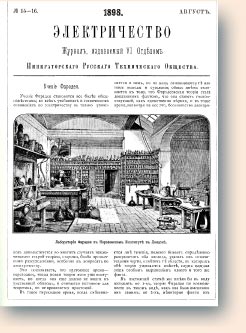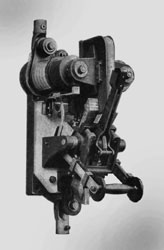The first electric meters. 1896, 1901

February 27, 1880 Electrotechnical department of the Imperial Russian Technical Society decided to publish the magazine "Electricity" - one of the first special electrotechnical journals.
The last third of the nineteenth century is a time when one does not expect "favors" from the physical world. For a society that enthusiastically used technical innovations (Singer sewing machines, McCormick mowers, "gutta-percha", aniline paints), electricity is "the force of nature that is at the service of humanity." Every week, every month the telegraph and magazines brought to the attention of the most respectable public news about any "new precious contribution to the young science" - electrical engineering.
While there was a matter of obtaining permission to publish the magazine in the censorship committee, the Electrotechnical Department held heated debates about the content and nature of the journal.
"The distribution among the reading public of necessary and extremely interesting ... information" about "still young physical strength", which "must be used in a very short time", "broad propaganda of ideas" - this will be the main goal of the publication, some thought.
The journal should mainly serve qualified electricians, i.e. To be "an open tribune for all who participate in their efforts in the success of electricity and its applications in art, industry and the hostel," insisted others.
As a result, the magazine placed on its pages not only theoretical articles, interesting for specialists, with mathematical formulas, descriptions of instruments and machines: (1896: "Recently a colossal current interrupter was built by the General Electric Company, this interrupter is designed for currents of 8000 amperes at 160 Volts, although it can also work at 600-700 volts.The clamps through which the current enters are 3.25 inches in diameter. "Or 1901:" Mr. Gentzch invented a new insulating substance consisting mainly of a mixture of ozocerite, amber , Asphalt and other materials.This substance has sufficient plasticity and does not crack at all while bending and twisting the cable "), but also publicly available articles, bibliographic information about books and articles in foreign journals, popular chronicles.
For example, in 1896 the electrotechnical public was entertained with a story about the illumination of the bell tower of Ivan the Great and the Kremlin during the coronation of Nicholas II: "The illumination of Moscow during the past coronation festivities presented a very beautiful picture. Against the backdrop of this picture, the Kremlin was particularly spectacular, which was decorated with great taste and grace by thousands of lights. Only using the services of electric power, it was possible to decorate with lights the spiers and eagles of the Kremlin towers, the dome and the cross of the bell tower of Ivan the Great.
Bulbs even illuminated the clock of the Spassky Tower, and the hands of the clock moved together with the incandescent bulbs fixed on them. For illumination, the Moscow branch of the Electric Lightning Society provided electricity at a rate of 3000 amperes at 170 volts, for a special charge, for feeding 12,000 incandescent lamps and 11 projectors of Mangin, and 8553 1/2 of the bare cable, 957 poods ...
The signal for the beginning of the Kremlin's illumination was the presentation of a bouquet of live roses to the Empress Empress with the incandescent lamps hidden in it, which were connected to a chain of electric wires leading to the Ivan the Great belltower. All the device of the Kremlin illumination was entrusted to the assistant of electrical engineering under the Ministry of the Imperial Court, the engineer-mechanic LR Shved ".
Intoxicated by the future, engineers and scientists (Lachinov, Yablochkov, Avenarius, Chikolev, Edison , Ferranti, Westinghouse) with unexpected fervor and pathos discussed on the pages of "journal notebooks" the options for including several lamps in the chain of one common generator or the advantages of direct and alternating current for transmission And distribution of electrical energy.  "Irreconcilable", full of curiosities, the struggle between the enthusiasts of gas and electric lighting and ways to control the consumption of a new type of energy is one of the permanent themes of the magazine: "The electric meter of the Hummel system of the firm" Schuckert and K "
"Irreconcilable", full of curiosities, the struggle between the enthusiasts of gas and electric lighting and ways to control the consumption of a new type of energy is one of the permanent themes of the magazine: "The electric meter of the Hummel system of the firm" Schuckert and K "
"When the production of luminous gas was improved so much that it was possible to start building gas plants to supply whole cities, most of it was an agreement between producers and consumers, according to which the latter received, for a certain amount, the right to burn a certain number of burners for a certain time. The shortcomings of the bad system were soon affected, since neither the manufacturer nor the consumer could be satisfied. The first could not account for the expenditure with changing needs, the second could not control expenditure and prevent abuse ... "
"If such conditions are still common in power plants and consumers use a certain number of incandescent lamps for a certain monthly fee, the reason for this should be found mainly in the distrust with which the public refers to electric meters .
Firstly, the public is generally afraid of electric units, such as amp, volts and others, which are not clear to it, and secondly, until recently meters have not fully met all those practical requirements that need to be put to a satisfactory device.
The Schukkert company, listing them in the description of its meter at 30 amperes at 110 volts, exposes its following advantages. In the foreground is the accuracy of the testimony ...
At Shukkert's meter, the deviation of the indicators from the truth does not exceed 1%. The device is so sensitive that it starts working immediately as even a single light bulb of 5 candles will be turned on. With its precise control, the device enables economical operation and preserves lamps and current.
A very important advantage of Schuckert's meter is that it does not contain permanent magnets, iron masses in operating organs, springs, or any other parts subject to changes. Therefore, the device registers the current consumption in the same way. "
"The counting mechanism, out of a few cogwheels and a small electric motor - these are the constituent parts of the Schuckert counter. This meter is completely independent and does not need any special devices for putting it into motion (for example, a clockwork factory) and comes into effect as soon as it passes current .... This meter is in great distribution; They produced more than 8000 pieces and installed in cities: Hamburg, Alton, Aachen, Munich, Budapest, etc. "
The journal "Electricity", March 1896.
"Improved counter of various systems" at the Paris World Exhibition in 1900.
"... Thompson's meter at 10 amperes at 110 volts with two shells, designed to prevent fraud. The whole mechanism is enclosed in one iron shell and the screws with which it is fixed on the stand are sealed by the plant. Only a collector with brushes is emitted from the shell; They are closed by a second shell, sealed with a society that gives energy, which can thus watch the meter without opening the mechanism ... The counter "Vulkan" differs from Thompson's counter only as a depressant, which causes a fairly precise adjustment. "
The Lux counter, "included in the chain itself and including the subscriber only when the coin is dropped into it, is paid for the energy that will be consumed from the moment the meter and the subscriber are switched on in the circuit .... They are most prevalent where the electric energy Is sold cheaply. "
"... variable rate meters. In them, the change in the energy record is made by means of clocks with a special adaptation, like an alarm clock. In the counter of the system "Brouten and Ruten", the clock is controlled by the main clock, located at the central station. These latter can thus delay or accelerate the progress of the counters, depending on the different hours or depending on the time of the year. This device allows you to use a very variable tariff, but when you use it you need an unconditional trust from the subscribers. "
"... double tariff counter" Electrical Joint Stock Company B. Shukkert in Nuremberg. " The purpose of the device is to count energy at different times at different tariffs. For this purpose, the meter is combined with a clock having for this purpose 2 dials for 12 day and 12 night hours.
Two arrows, as on an alarm clock, you can limit the time or rather those hours that one or another tariff should be counted as a counter. The clock itself is equipped with a pendulum and electric drive. The device has very ingenious details, for the description of which, unfortunately, there is no room here. "
" Generally speaking, existing electric meters meet all the requirements of practice and their accuracy is at least equal to the accuracy of the best industrial devices, since the error rate never exceeds 2-3%."
The journal "Electricity", July 1901


Comments
When commenting on, remember that the content and tone of your message can hurt the feelings of real people, show respect and tolerance to your interlocutors even if you do not share their opinion, your behavior in the conditions of freedom of expression and anonymity provided by the Internet, changes Not only virtual, but also the real world. All comments are hidden from the index, spam is controlled.